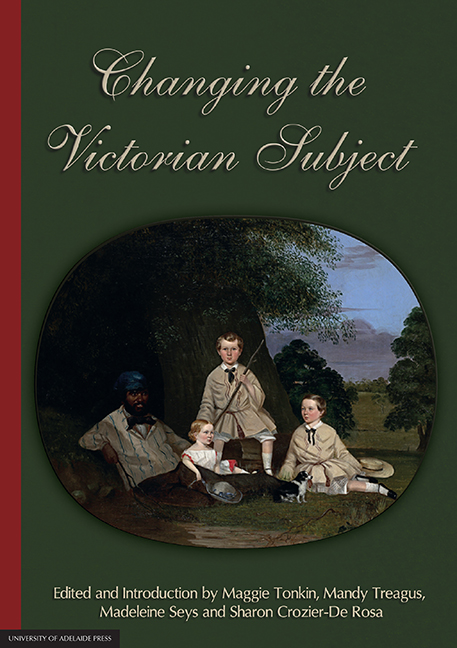Book contents
- Frontmatter
- Contents
- Notes on Contributors
- 1 Re-visiting the Victorian subject
- 2 Queen Victoria's Aboriginal subjects: a late colonial Australian case study
- 3 Identifying with the frontier: Federation New Woman, Nation and Empire
- 4 A ‘Tigress’ in the Paradise of Dissent: Kooroona critiques the foundational colonial story
- 5 The making of Barbara Baynton
- 6 A literary fortune
- 7 Olive Schreiner's From Man to Man and ‘the copy within’
- 8 Guy Boothby's ‘Bid for Fortune’: constructing an Anglo-Australian colonial identity for the fin-de-siècle London literary marketplace
- 9 The scenery and dresses of her dreams: reading and reflecting (on) the Victorian heroine in M.E. Braddon's The Doctor's Wife
- 10 The woman artist and narrative ends in late-Victorian writing
- 11 Miss Wade's torment: the perverse construction of same-sex desire in Little Dorrit
- 12 ‘All the world is blind’: unveiling same-sex desire in the poetry of Amy Levy
- 13 From ‘Peter Panic’ to proto-Modernism: the case of J.M. Barrie
9 - The scenery and dresses of her dreams: reading and reflecting (on) the Victorian heroine in M.E. Braddon's The Doctor's Wife
Published online by Cambridge University Press: 05 December 2014
- Frontmatter
- Contents
- Notes on Contributors
- 1 Re-visiting the Victorian subject
- 2 Queen Victoria's Aboriginal subjects: a late colonial Australian case study
- 3 Identifying with the frontier: Federation New Woman, Nation and Empire
- 4 A ‘Tigress’ in the Paradise of Dissent: Kooroona critiques the foundational colonial story
- 5 The making of Barbara Baynton
- 6 A literary fortune
- 7 Olive Schreiner's From Man to Man and ‘the copy within’
- 8 Guy Boothby's ‘Bid for Fortune’: constructing an Anglo-Australian colonial identity for the fin-de-siècle London literary marketplace
- 9 The scenery and dresses of her dreams: reading and reflecting (on) the Victorian heroine in M.E. Braddon's The Doctor's Wife
- 10 The woman artist and narrative ends in late-Victorian writing
- 11 Miss Wade's torment: the perverse construction of same-sex desire in Little Dorrit
- 12 ‘All the world is blind’: unveiling same-sex desire in the poetry of Amy Levy
- 13 From ‘Peter Panic’ to proto-Modernism: the case of J.M. Barrie
Summary
In Mary Elizabeth Braddon's 1864 novel, The Doctor's Wife, heroine Isabel gazes into the looking glass ‘to see if she really were pretty; or if her face, as she saw it in her day-dreams, was only an invention of her own, like the scenery and the dresses of those foolish dreams’ (155). Throughout The Doctor's Wife, Braddon explores the mirror's dual capacity to fashion fantasy and register reality. In the mirror, Braddon fashions a new symbolic relationship between reading and dressing and, thereby, metafictionally negotiates Isabel's dual position as reader and heroine, subject and object in the novel. Dressing, reading and dreaming in front of the looking glass, Isabel self-consciously acts out the construction and representation of the heroine in the Victorian novel. At the same time, Braddon negotiates shifts in conceptions of feminine and literary subjectivity in The Doctor's Wife and fashions a form of highly self-conscious and culturally receptive authorship and readership in the genred literary climate of the mid-nineteenth century.
The Doctor's Wife traces the life and reading of Isabel Gilbert (née Sleaford) from naïve adolescence to wisdom and maturity. Like many female members of ‘the poorer middle classes’, Isabel has received a ‘half-and-half education’ (Braddon 27). The narrator advises us that she
knew a little Italian, enough French to serve for the reading of novels that she might have better left unread, and just so much modern history as enabled her to pick out all the sugarplums in the historians' pages … She played the piano a little, and sang a little, and painted wishy-washy-looking flowers on Bristol-board. (27)
- Type
- Chapter
- Information
- Changing the Victorian Subject , pp. 177 - 200Publisher: The University of Adelaide PressPrint publication year: 2014



